Author: pbecadmin
The Last Leg of International Travel: CEM Quarantine
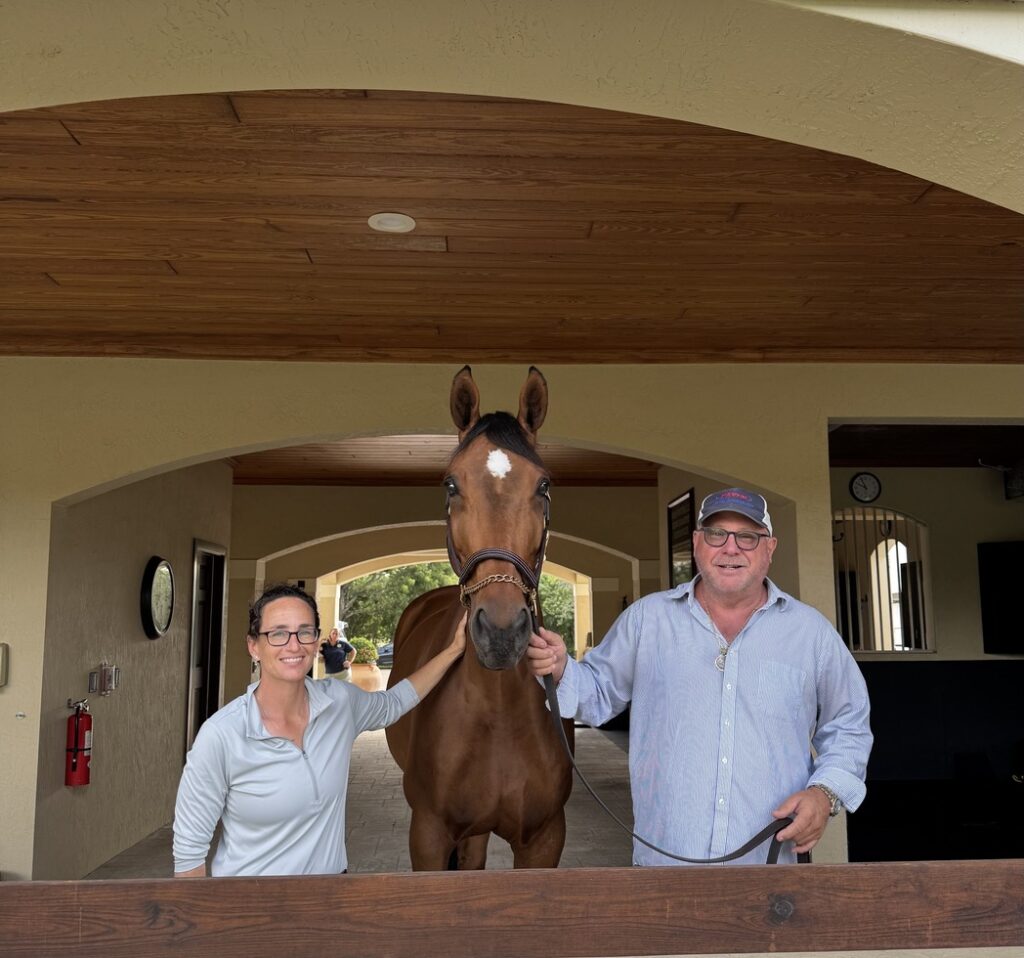
Whether returning home after a thrilling summer competing on the European circuits, traveling from a home base abroad, or importing a newly purchased equine, every horse entering the United States must follow specific guidelines based on the country of origin. Once the horse “clears customs” at the airport, satisfying United States Department of Agriculture (USDA) import requirements, there’s one more thing owners must consider before their horse reaches its final destination.
Mares and stallions remaining in the United States beyond the temporary stay period must undergo additional quarantine for Contagious Equine Metritis (CEM). This sexually transmitted bacterial infection can cause infertility in mares and is carried by stallions. While endemic in Europe, the disease is not currently in the U.S., so testing and quarantine for horses entering the country from areas with confirmed cases are essential to maintain that disease-free status.
Fortunately for horses traveling to Florida, Palm Beach Equine Clinic’s Dr. Jordan Lewis works closely with Richard Faver at Ossian Ventures, one of the largest commercial CEM quarantine facilities in Florida, to oversee and conduct the rigorous testing process, which differs based on whether the animal is a mare or stallion.
“Mares are usually with us for about 15 days. They need three sets of negative cultures, 72 hours apart, and then five days of washing with chlorhexidine and applying silver sulfadiazine as a topical treatment, which we call ‘clean and pack,’” explained Dr. Lewis, adding that they take samples from three areas of the mare and also pull a blood test, called a complement fixation (CF). The CF results and each set of cultures must be sent by mail to a lab for testing, and turnaround times are about a week for the cultures and a few days for the blood.
“Stallions are a little different,” continued Dr. Lewis, noting that their process takes about 35 days. Within the first few days, a culture is taken from the stallion and sent for testing.
“When the culture comes back negative, we have a set of mares called test mares that are cycled and ready to breed,” she said. “Those stallions live cover two test mares, which then start getting cultured on day three post-breeding. They go through the same process as the other mares: three sets of cultures, 72 hours apart. Twenty-one days after breeding, they do the CF test on those mares.”
Dr. Lewis noted that the test mares undergo a process called “short cycling” to ensure they will not become pregnant from these breedings. Each stallion also receives a clean and pack treatment after breeding and can then be released once all testing returns negative.
Throughout the horse’s stay at Ossian Ventures, Dr. Lewis and other Palm Beach Equine Clinic veterinarians are available to provide any additional care the animal might need after its long journey, including Coggins testing, if necessary, in preparation for the next step in the horse’s travel plans. Owners are welcome to visit and ride during this time, given that horses are kept from interacting, and any equipment that touches the animal stays at the facility and is only used on that horse.
“I just enjoy being part of the process,” shared Dr. Lewis about her role in maintaining the health and safety of the horses in quarantine. “Plus, we certainly get to see some world-class horses coming through, which is fun.”
There are many factors to consider when traveling internationally with horses, but the Palm Beach Equine Clinic is dedicated to providing quality care at every step, from touchdown at the airport to quarantine and beyond. This is the final article in a three-part series by Palm Beach Equine Clinic veterinarians detailing the rules and procedures of importing and exporting horses. Read part one on exporting horses by Dr. Janet Greenfield, followed by her second article on importing horses for temporary stays in the October and November issues of The Plaid Horse magazine. Contact Palm Beach Equine Clinic at 561-793-1599 for any equine health needs.
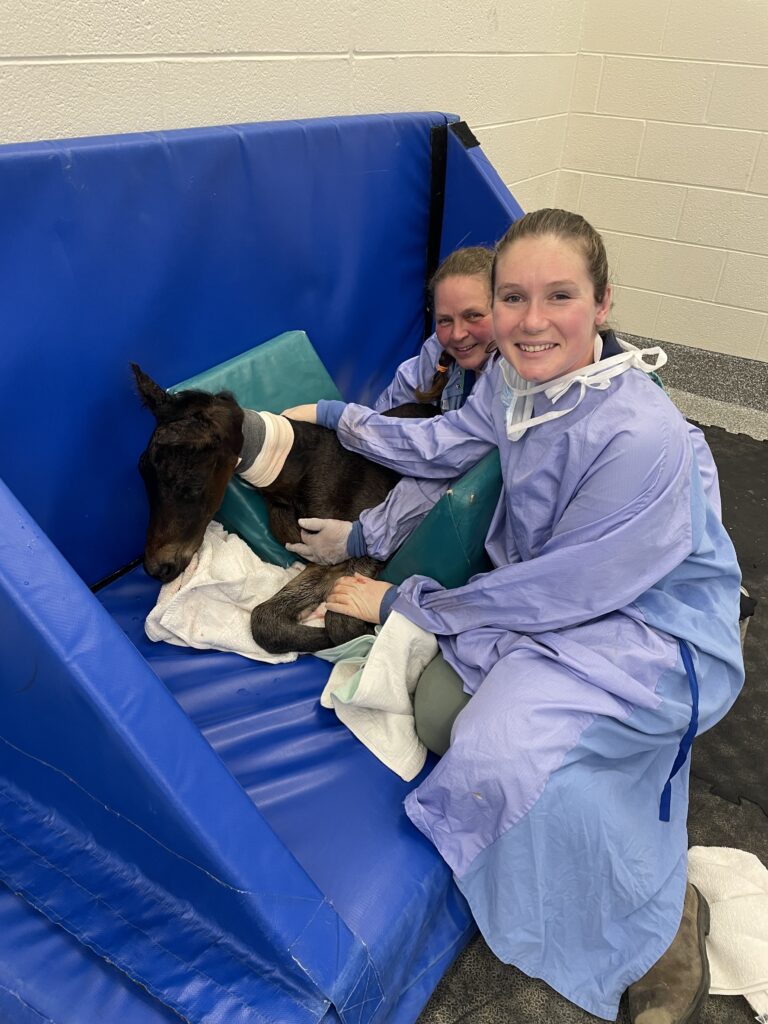
Photo courtesy of Dr. Emilee Lacey
Learn More About Dr. Emilee Lacey, Palm Beach Equine Clinic’s New Internal Medicine Specialist
Dr. Emilee Lacey grew up in California, graduated from the University of Pennsylvania in 2021, and completed an internship at Sports Medicine Associates of Chester County in Cochranville, PA. She has been immersed in the sport horse world her entire life, but her passion for managing fevers, respiratory disorders, and neurologic disease led her away from lameness exams and toward internal medicine. Dr. Lacey completed her large animal internal medicine residency and obtained a Master’s of Science in Biomedical and Veterinary Sciences at Virginia Tech in Blacksburg, VA, this summer. She joined Palm Beach Equine Clinic in August 2025.
What first sparked your love of horses?
My love for horses started at a very young age, but it was really nurtured by my horse-loving grandmother, aunt, and mom. After what felt like years of begging, my mom finally put me in horseback riding lessons when I was in grade school. After about a year of consistent riding, I convinced my mom to let us buy my aunt’s horse, Chili, an off-the-track Thoroughbred (OTTB) that was barely restarted and literally lived across the country in Maryland. She came off the trailer in California like a typical green OTTB: head straight up in the air, nostrils flared, and breathing like a dragon. I was only seven years old at the time, and I thought this was the BEST DAY EVER. My trainer had very different thoughts. This mare not only taught me to ride; she also taught me valuable horsemanship skills I still utilize today. Many other horses have come after Chili, but this mare will always be the spark that truly ignited my love for horses.
What inspired you to become a large animal veterinarian?
I’ve known I wanted to be a veterinarian since I was three years old. I halfheartedly joke that the words “I want to be a vet” were actually my first coherent words. I spent my childhood years obsessed with every TV show or movie that even slightly mentioned veterinary medicine, earned every Girl Scout patch remotely related to veterinary medicine or animals, and volunteered as much time as I could in any clinic or with any equine veterinarian that would take me.
When I finally made it to veterinary school, I was convinced I had to be a small animal veterinarian to have time for my own horses. I was so wrong! During my studies at the University of Pennsylvania, I met many vets who had their own horses and hobbies while maintaining an excellent work-life balance. I also realized that not only was I more interested in large animal medicine, but I was also better at it because I could connect with the owners. I am a horse owner first, and a veterinarian second. I understand how these special animals can become a part of your family.
After veterinary school, I completed an internship with Sports Medicine Associates of Chester County in Pennsylvania. I developed a special interest in managing poor performance that is not related to lameness. Diseases like Equine Asthma, myofibrillar myopathy, gastric ulceration, chronic hepatopathy, and heart murmurs all pulled me away from lameness exams and toward internal medicine. After my internship, I was humbled and honored to complete a large animal internal medicine residency at the Virginia-Maryland College of Veterinary Medicine in Blacksburg, VA. This three-year-long opportunity was a lot of hard work, but I loved every minute. When you love what you do, it doesn’t feel like work. I truly have the best job in the world!
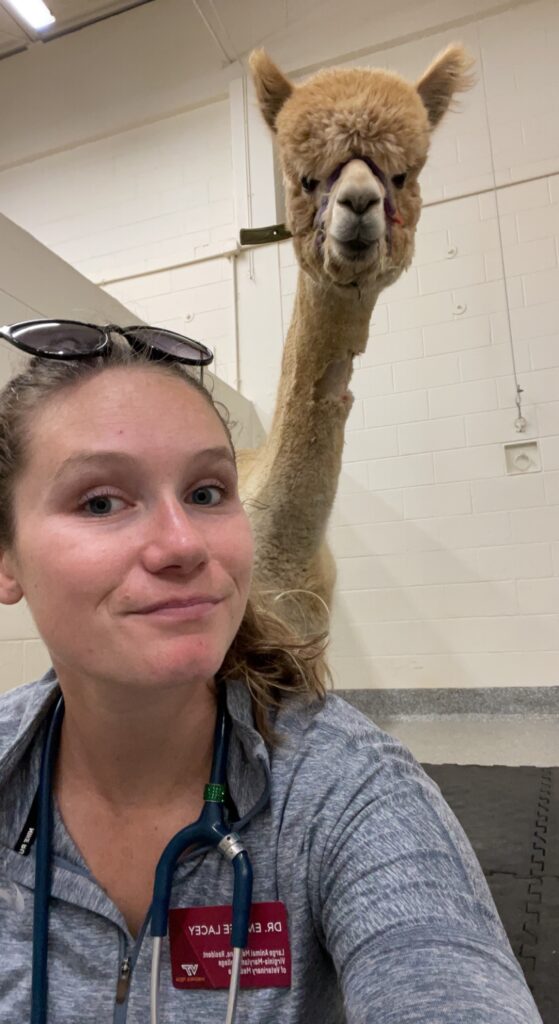
Photo courtesy of Dr. Emilee Lacey.
How did that path lead you to Palm Beach Equine Clinic?
I found my way to Palm Beach Equine Clinic through a few mutual patients while completing my residency in Internal Medicine at Virginia Tech. While caring for these patients in the hospital, I was collaborating with [PBEC Founder] Dr. Paul Wollenman almost daily for a few weeks. During this time, [PBEC President] Dr. Scott Swerdlin reached out to me to gauge my interest in a job opportunity with PBEC. I was so impressed with the communication and collaboration among the veterinarians at this hospital, but what really convinced me was their dedication to excellent patient care. At PBEC, care doesn’t stop when an animal is discharged. The veterinarians here will continue to check in on your horse long after they’ve returned to the barn, and there’s also a team of other veterinarians, technicians, and support staff ready to help you if needed.
What are your current responsibilities or areas of focus at PBEC?
My current area of focus at PBEC is equine internal medicine. This is a specialized branch of veterinary medicine that focuses on the diagnosing and treating diseases affecting internal organ systems, including the heart, lungs, gastrointestinal tract, kidneys, liver, endocrine system, central nervous system, and others. I primarily care for patients in the hospital that require intensive care, but I also dedicate time to recheck examinations and consultations in the field. I tell my friends and family that my job is similar to a human physician working in an intensive care unit in a hospital.
What does a typical day on the job look like for you?
A typical day starts with morning rounds with our associate veterinarians, surgeons, and intern veterinarians to review the status of our current inpatients and update their treatment plans. After rounds, I review any completed daily bloodwork and complete any pending diagnostics, like recheck ultrasound examinations or a gastroscopy, for the current inpatients. I might spend the afternoon at nearby farms completing recheck examinations on previous patients, consulting on new cases from other veterinarians, or conducting an outpatient appointment in the hospital. I am also available for incoming emergency admissions, which can happen quite frequently and without much notice! At the end of every day, I round again with our intern veterinarians, which ensures excellent patient care in a collaborative environment.
What do you enjoy most about being part of the PBEC team?
My favorite part of working at PBEC is the ability to collaborate openly with veterinarians of different specialties and backgrounds. A person simply cannot know everything, and there is always more than one right way to do something. It’s really special to be able to walk down a hallway and talk to three different surgeons about their experiences with a certain diagnosis!
What new technology or recent advancements in veterinary medicine do you find most exciting?
I am most excited about recent advancements in therapeutic options for the management of equine metabolic disease (EMS). EMS is a common endocrine disorder associated with a horse’s inability to regulate their insulin levels – similar to “pre-diabetes” in humans. Horses with EMS are at high risk of developing laminitis, which can be life threatening. Historically, EMS was only managed with dietary changes and the limited efficacy of a short list of medications.
Now with the current use of ertugliflozin, a medication belonging to a class of drugs called sodium-glucose cotransporter 2 (SGLT2) inhibitors, we have another option to reduce a horse’s insulin level in an attempt to prevent laminitis. Further studies are needed regarding long-term use, but we have seen some promising results over the last few years in clinical practice. As a horse owner who lost her heart horse to laminitis, it is really rewarding to help horses who suffer from this condition now.
What’s the most challenging part of being an equine veterinarian, and how do you handle it?
The most challenging part of being an equine veterinarian is convincing young, aspiring veterinarians to join our field! We are facing a national crisis due to the shortage of large animal veterinarians. More newly graduated veterinarians are entering small animal practice, there is an increased rate of early-career equine veterinarians leaving the profession, and a significant number of equine veterinarians are nearing retirement. One of my goals as an equine veterinarian is to show the younger generation that this is the best job in the world. I try to create a welcoming environment for learning by hosting externs and teaching interns every chance I can get. We need more horse vets!
What’s the most rewarding part about serving the equestrian community?
The most rewarding part of serving the equestrian community is having the opportunity to give back to the community that gave me so much growing up. I was so blessed to be surrounded by such thoughtful and caring horse trainers, owners, and veterinarians who cared for me like I was family. I was raised in the horse world, and it’s surreal and humbling to be able to care for these special animals during their most vulnerable times. I hope I never have to meet you and your horse in the hospital during an emergency, but if I do, I understand what it’s like to be the emotional owner! I’m here to care for your horse and support you in whatever decisions we need to make for them.
Is there a particular case or experience you’ve had at PBEC that has been especially meaningful to you?
My first few weeks at PBEC have been filled with some unusual cases, but one pony in particular has gained a special place in my heart. This pony was sick for a few days before being admitted to the hospital. Upon initial examination, I diagnosed an intra-abdominal mass. Through aggressive supportive care as well as anti-inflammatory and antibiotic medicines, this mass has decreased substantially in size, and the pony was able to go home. This pony went from being dull and not eating to being very difficult to catch and developing a voracious appetite. I recently received a video of him playing in a sprinkler at home. Success stories like this remind me of why I chose to pursue this career.
What advice would you share with those who dream of becoming equine veterinarians one day?
To those horse-crazy girls and boys thinking of being an equine veterinarian, don’t give up on your dream! Take every opportunity you can to be around horses, and network with any veterinarian you can. Be brave and introduce yourself – most of us love to chat about this job. If you find yourself in Florida, don’t hesitate to contact PBEC to set up an externship. We need you to join our profession!
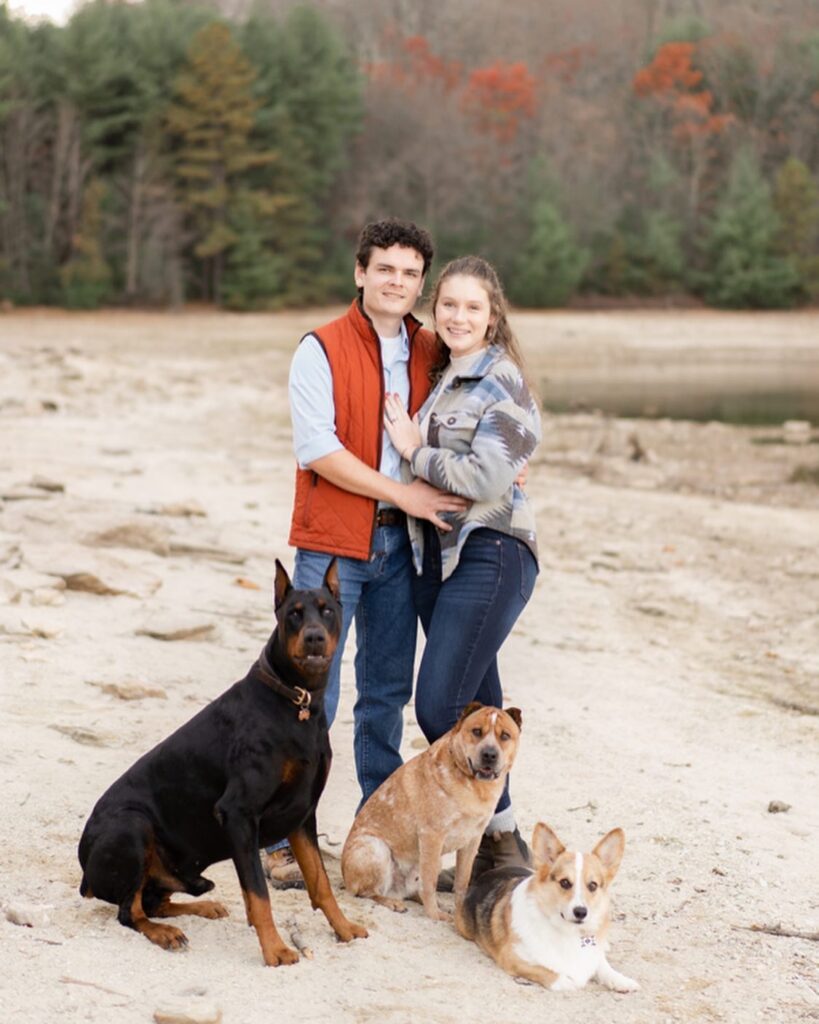
Photo courtesy of Dr. Emilee Lacey.
When you’re not at work, what do you enjoy doing to relax and recharge?
When I’m not at work, you can catch me riding my horse, William, a 16-year-old OTTB gelding who has had me wrapped around his hoof since he was three years old. I have had this horse just a few months longer than I have known my husband, Mike. When I’m not at the barn, Mike and I enjoy walking our dogs on the beach, scuba diving, or simply enjoying a sunny afternoon at the pool with our family. It’s so important to have an identity outside of being a veterinarian, and I aim to be that example!

Where are you from?
I was born and raised in Switzerland, where we speak four national languages —German, French, Italian, and Romansh (an old Swiss tongue that’s still hanging on). I’m from Geneva, which is in the French-speaking part of the country and the best Swiss
city in my humble opinion.
Where did you earn your degree?
In Switzerland, you can only earn a veterinary degree in the German-speaking part. When I was just four years old, I asked my mom if it was possible to have a vocation because I already felt like mine was becoming a veterinarian. Thanks to my parents’
unwavering support, I was able to attend a bilingual school to learn German properly. I eventually studied veterinary medicine at the University of Zurich, which is in the largest city in Switzerland. Back home, veterinary school is structured into a three-year
Bachelor’s program followed by a two-year Master’s. After completing both, we take the federal veterinary licensing exam to become fully qualified.
What is your background with horses?
I started riding when I was three years old and later competed in show jumping for almost 10 years. I had to pause during vet school, but horses have always remained the love of my life. I used to say that my passion wasn’t actually show jumping — it was
taking care of my horses, spending time with them, and getting to know them like my own friends.
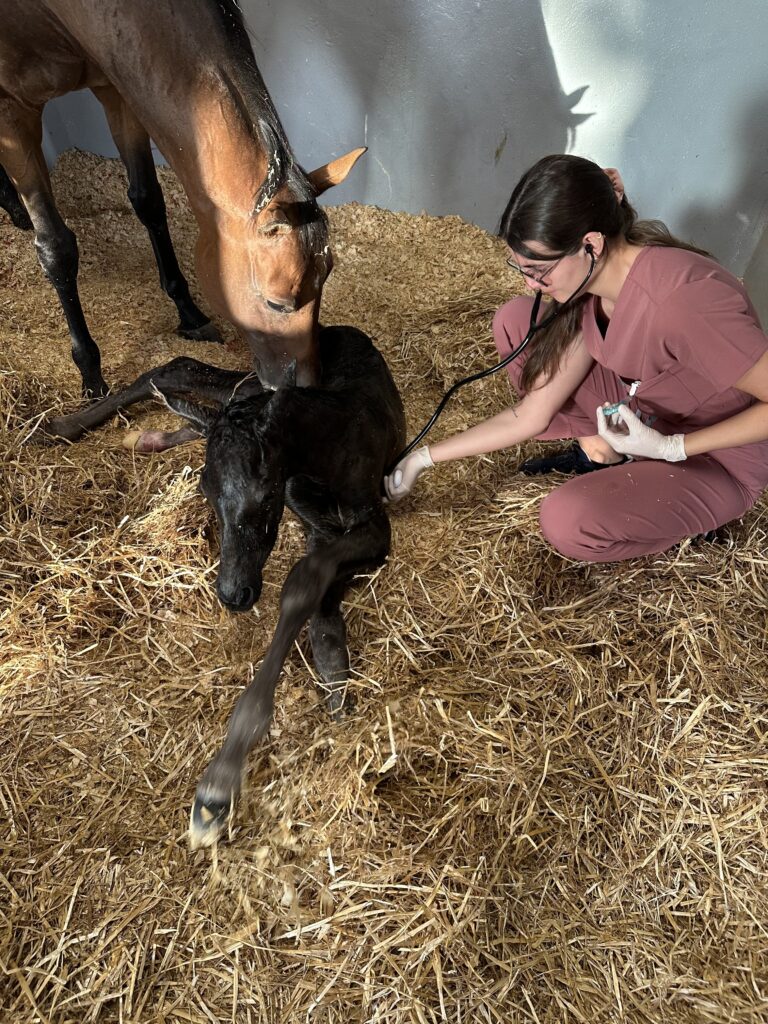
What brought you to PBEC?
I did a four-week externship at PBEC about two and a half years ago and was absolutely starstruck by the level of equine medicine practiced here. The variety of disciplines and cases, combined with the opportunity to learn new ways of practicing,
made me determined to come back.
I love sports medicine, and here you get to see everything — dressage, show jumping, polo, barrel racing, bucking horses, pleasure horses, and even Thoroughbreds. Each discipline brings its own veterinary challenges, and that variety is what makes PBEC so exciting. The clinic’s facilities and the range of specialties, from sports medicine and internal medicine to reproduction and ophthalmology, make it an incredible place to learn. Also, doing an internship in a private clinic rather than a university allows me to practice more hands-on medicine and grow more confident and independent in my clinical decision-making.
What was the process of becoming an intern?
Honestly, it was easier than I expected, thanks to the amazing support from Dr. Swerdlin and his team. I filled out a couple of forms, submitted some documents, made a quick visit to the U.S. Embassy in Switzerland, and I was good to go. They really made the whole process smooth and stress-free. Once I arrived, I had to schedule an appointment to get a Social Security number.
As an international intern, I was a bit worried about housing and transportation, but the clinic has everything well thought out. We’re provided with free housing in a lovely house surrounded by nature, and the company also offers cars for international interns who can’t purchase one at the time of arrival. PBEC really ensures we have great living conditions so that we can fully focus our energy on the internship.
What is the program like so far?
It’s definitely challenging — not just the workload but also being so far from my family and friends for the first time, adjusting to a new environment and the working world, as well as figuring out how to be the kind of veterinarian I want to become. It’s not always easy —internships aren’t for everyone — but I’m adapting.
My colleagues and supervisors have been incredibly supportive, and that makes a huge difference. This program exposes me to every corner of equine medicine, helping me decide what path I want to pursue in my career. And I get to learn from some of the
most experienced and generous equine vets out there.

when choosing an internship at PBEC. Photo courtesy of Sarah Océane Graf
What is a typical day like for you?
I usually get to the clinic around 6 and 7 a.m. to check on my patients and write their SOAPs (notes that stand for Subjective, Objective, Assessment, and Plan). At 8:30 a.m., we have morning rounds with the surgical resident and clinicians where we go
over every patient, update their plans, and ask questions to better understand the cases.
After rounds, depending on my rotation, I might scrub into surgery, run anesthesia, or take in emergency cases. If I have a quieter moment, I’ll research my cases to deepen my understanding or help with outpatient procedures. I also just enjoy spending time
with the patients.
At 5:30 p.m., we do rounds with the overnight intern, who stays at the clinic until midnight (or later, depending on the case load) and is then on call until 8 a.m. One of the day interns is also on call for anesthesia each day.
What is something new that you’ve learned?
So much, and it’s only been a month. I can now confidently run general anesthesia, place arterial and venous catheters, perform abdominocentesis, and do a flash ultrasound. I even got to inject a coffin joint! I’ve also spent time in the reproduction
department and can now perform transrectal ultrasounds of the mare’s reproductive tract, do uterine flushes and infusions, and place urinary catheters. The list keeps growing, and I’m so grateful for the learning opportunities.
What do you do in your free time?
I brought my dog, Pepper, with me, so we spend time at the beach in Palm Beach or Jupiter, run around the neighborhood, or go to the dog park. In the evenings or on weekends, I read and re-read Harry Potter.
I’ve also discovered the wonders of Target, Whole Foods, and the mall… I may or may not have spent at least 24 hours there already.
And of course, I call my boyfriend… who patiently listens to me talk about transrectal ultrasounds while wondering where his life took a very specific turn.
Palm Beach Equine Clinic served as Official Treating Veterinarian during the Longines Global Champions Tour (LGCT) of Miami Beach in Miami, FL, from Sunday, April 9 through Sunday, April 16, 2023. Dr. Christopher Elliott was on-site daily during this international competition. Keep reading to learn about Dr. Elliott’s week while at this one-of-a-kind venue.

Photo courtesy of Dr. Christopher Elliott
Arrival of International Horses – Sunday, April 9, 2023
The first day started at the airport with the arrival of the international horses. During this process, Palm Beach Equine Clinic veterinarians worked alongside the government veterinarians from the United States Department of Agriculture (USDA) to make sure all the horses arriving were happy and healthy. While the horses were still on the airport tarmac, a team of government and local veterinarians performed the first two steps of the arrival process. First, we checked and cross-referenced microchips to confirm each horse’s identity. Then we took blood samples from each horse.
All horses entering the U.S. had to be in quarantine for 48 hours under USDA government control. There are very strict veterinary protocols to ensure no diseases are inadvertently introduced into the country. Upon arrival in quarantine, horses were inspected by the USDA veterinarians for any evidence of illness or injury. All the horses in quarantine had their temperature taken and were inspected for any ectoparasites.
After being strictly monitored, including twice-daily veterinary inspections and temperature checks, the international horses were released from strict quarantine into the controlled competition environment. The international horses were housed in separate stables from domestic American horses. They were also kept separate in the training arena. Throughout the duration of the competition, all international horses were strictly monitored by both government veterinarians and the official veterinarians of the competition. All of these procedures are designed to prevent the inadvertent introduction of foreign or infectious diseases and protect the U.S. horse population. Fortunately, all of the international horses that arrived in Miami had no health concerns.
Arrival Examination Day for National Horses, Horse Inspection, and Arena Familiarization – Thursday, April 13, 2023
I began Thursday at the competition venue with the arrival examination for all FEI horses who were already in the United States.
We inspected each national horse for any obvious signs of illness or injury, and then we scanned their microchip. Our microchip readers are linked via Bluetooth to our phones so when we scan a microchip, we can see all of the horse’s FEI details within the veterinary side of the FEI HorseApp. The app gives us all the information we need to know about the horse and whether all of the documentation was done correctly. Before the horses arrived at the competition venue, the owners and riders were required to complete documentation on the FEI HorseApp including the self-declaration of health stating that their horses were healthy prior to arriving at the venue. They also had to take their horses’ temperatures in the morning and evening for three days prior to arrival at the FEI venue and record it in the app.
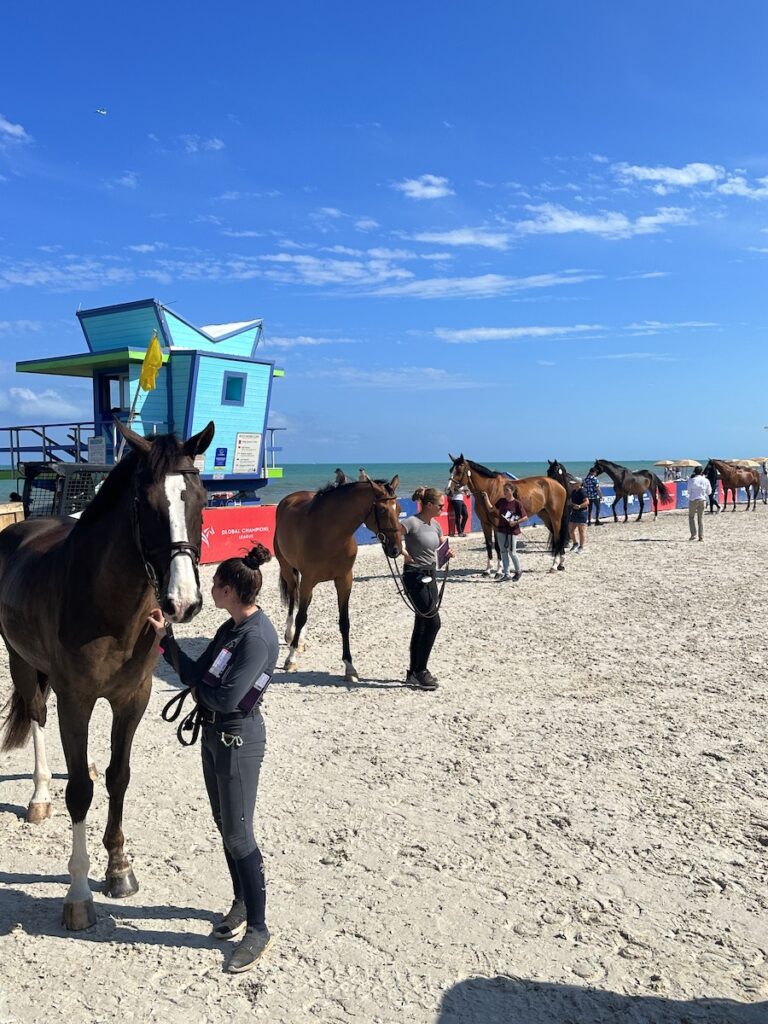
Photo courtesy of Dr. Christopher Elliott
After we checked that information, we looked at the horse’s passport to make sure it was up to date with all of its vaccinations. We checked that the last Equine Influenza vaccination was within six months and 21 days of arrival at the horse show. We also asked the rider or groom to take the horse’s temperature right then and there to make sure it is good.
Once the horses were all checked in, the horse inspection for national and international horses got underway. I supervised all of the national and international horses going through horse inspection. As the Official Treating Veterinarian, I worked with the veterinary delegate who traveled in from Italy since LGCT has a very international team. During the horse inspection, my role was to make sure everything ran smoothly. I was also there to examine any horses that might not have been successful through the jog but fortunately they all passed the jog. After the horse inspection, it was time for arena familiarization and schooling where I stood ringside to make sure all horses stayed injury free.
Competition Days – Friday, April 14 through Sunday, April 16, 2023
The competition days started really early. Thankfully at this event it’s not too bad because you get to see the sunrise over the ocean. The warm-up and schooling arena opened at 5:30 a.m., so I was on-call by the schooling arena then to make sure all horses were happy and healthy.

Photo courtesy of Dr. Christopher Elliott
Once the competition began, I was right there at the in-gate with the emergency veterinary kit bag just in case I needed to attend to any horses in the ring. Fortunately we only had to look at a couple of very minor things throughout the competition.
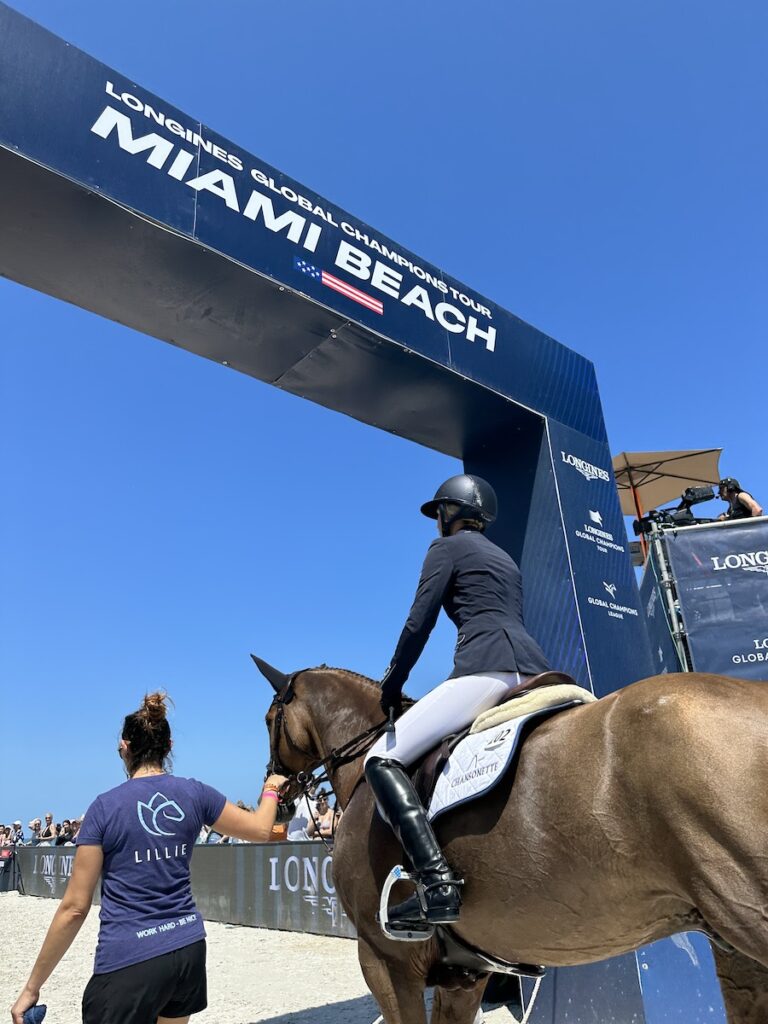
Photo courtesy of Dr. Christopher Elliott
In the afternoons my role changed to supporting the horses’ recovery from the competition day. Dr. Sarah Allendorf from Palm Beach Equine Clinic came down from Wellington each afternoon to help. Between the two of us, we examined horses after they competed and advised riders and grooms on how best to look after them in preparation for the next day. We administered some supportive therapies within the rules of the FEI. On Saturday it was very hot and humid, so we administered some fluids to help the horses recover and ensure they were fit and healthy for the following day.
On Sunday afternoon while the final CSI2* competition was taking place, Dr. Allendorf and I prepared the international horses for their next journey. We made sure the horses were healthy and ready to travel. We escorted them to the airport where they went on to the next LGCT event – Mexico City!
On Sunday afternoon while the final CSI2* competition was taking place, Dr. Allendorf and I prepared the international horses for their next journey. We made sure the horses were healthy and ready to travel. We escorted them to the airport where they went on to the next LGCT event – Mexico City!
As winter winds down and everyone looks ahead to the exciting spring and summer show season, there are preparations that can be taken in your horse’s care to ensure you get off on the right hoof. Close communication with your veterinarian can help you stay on track and ensure everything is properly addressed. Vaccinations, deworming, therapies and treatments, as well as shipping care and paperwork are all important to think about. At Palm Beach Equine Clinic in Wellington, FL, Dr. Elizabeth Barrett works with her clients to stay organized for the upcoming show season.
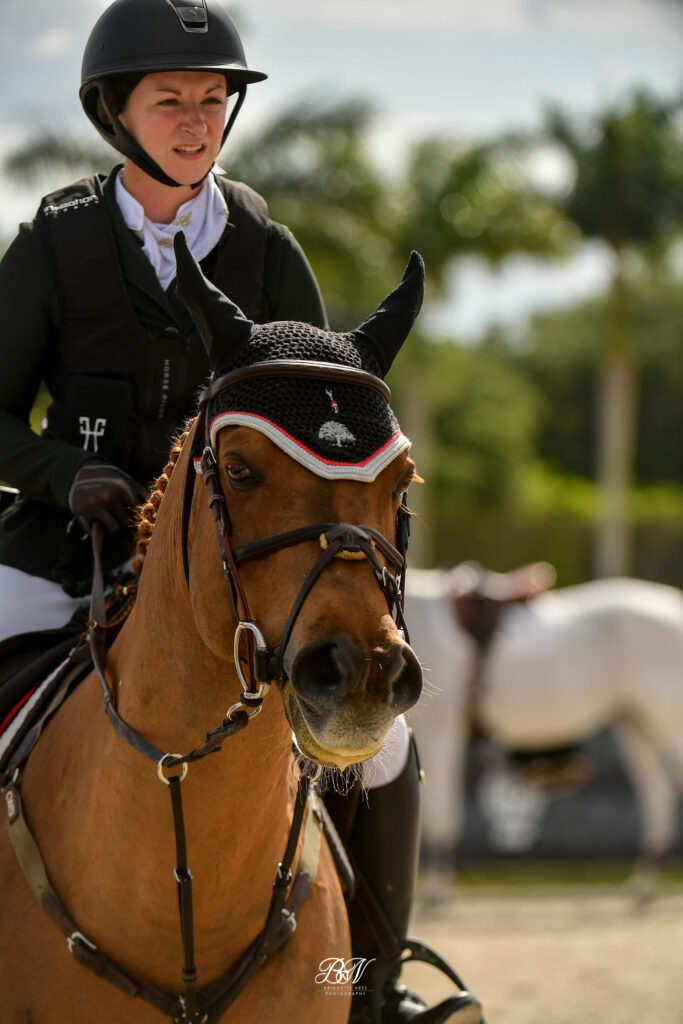
Photo by Bridget Ness Photography
Vaccinations
Horses are generally vaccinated twice per year in the fall and spring. If you and your horse are traveling to a new area for the spring and summer season, it is important to think about the requirements of that area or diseases more commonly found there. As an example, Dr. Barrett notes that the Potomac Fever vaccine is not always administered in Florida but can be important for horses traveling to the northeastern part of the country.
Vaccinations also need to be administered with enough time prior to shipping or competing, making scheduling considerations more crucial. Dr. Barrett maintains consistent communication with her clients to find the most optimal day to vaccinate such that it coincides with the horse’s existing schedule. While horse owners and barn managers help organize timing, Dr. Barrett stays prepared on her end by counting her patients and ordering enough vaccines for them.
“The responsibility goes both ways,” said Dr. Barrett. “Usually, the farm manager will let me know that they have some time off from showing, so it’s a good time for spring vaccines. I might also remind them that it’s getting to be time to do that so they can work it into their schedules.”
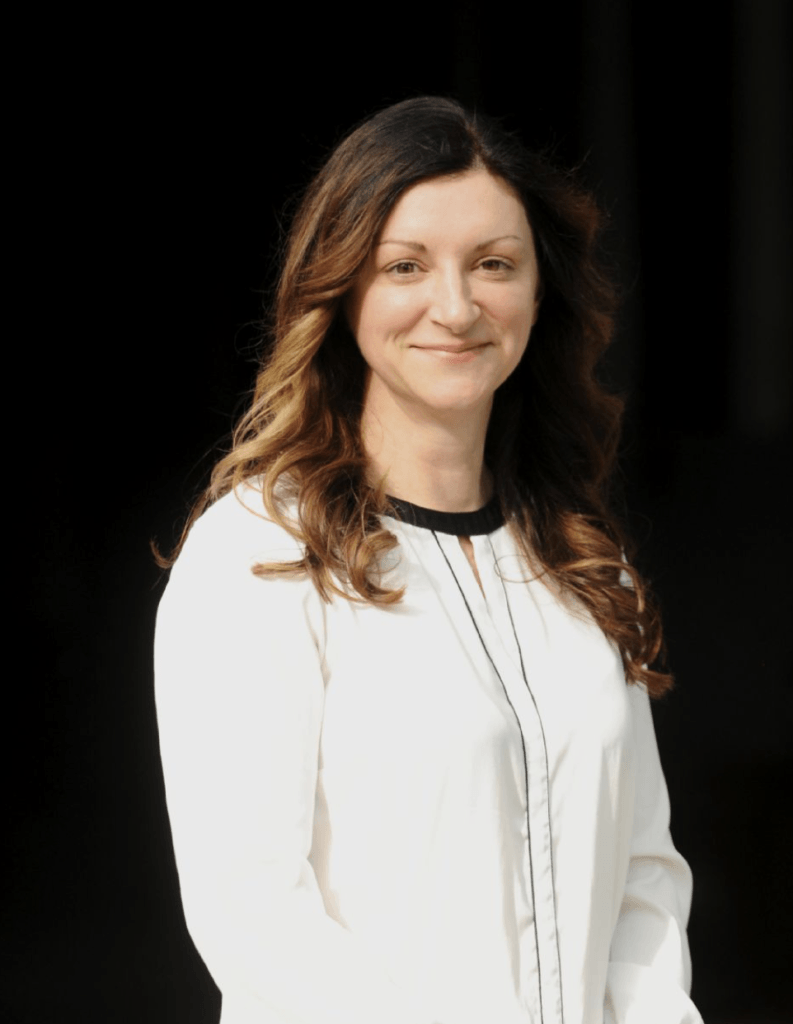
Photo courtesy of Dr. Elizabeth Barrett
Deworming
Springtime is also a good opportunity to deworm. When horses have traveled from one area to another, it is more crucial. While Dr. Barrett recommends worming twice annually, she explained that it is necessary to pay attention to each individual horse. Examining the horse and knowing the horse’s situation should guide the worming program. Horses that show clinical signs of worms, such as issues with weight and coat, should have a fecal egg count performed no matter what time of year.
Therapies and Treatments
Many horses are completing busy winter show schedules and heading into a break before ramping back up again. This downtime is a great window of opportunity to help address any issues that may have emerged. Dr. Barrett suggests having your horse treated at the beginning of a break to allow more time for the treatment to settle in. Some joint injections and therapies require longer recovery times, so that needs to be planned accordingly.
“After the winter show circuit, I go over all the horses completely to see if there are any issues,” detailed Dr. Barrett. “If there is any lameness or any maintenance we need to do, we try to time it so that the horse has at least a small break before they ship to their next show. Sometimes the horse just needs downtime, and during the spring is often the time they can get that rest. It’s also a good time for different training routines, such as a water treadmill or hill work to change up the program a little bit.”
Shipping
Spring and summer showing and shipping go hand in hand. Remembering all the paperwork that needs to be completed ahead of time is key to avoiding a last-minute scramble. Health certificates and Coggins papers are necessary documents for horses to travel both domestically and internationally. Dr. Barrett notes that it takes at least two days for a vet to complete this paperwork for national travel, so it is essential to keep that in mind when arranging an interstate trip. International travel health certificates take longer to prepare and have more requirements, necessitating additional forethought.
Once the logistics are handled, the horse must be physically prepared to ship. The longer the trip, the more stress it can put on the horse. Even trips as few as three hours can increase health concerns. Stomach ulcers are always a risk, so Dr. Barrett suggests administering preventative omeprazole paste to help keep your horse comfortable. Again, Dr. Barrett stresses that each horse needs to be considered individually, so a horse more prone to ulceration might also benefit from sucralfate when shipping.
“I would scope the stomach of any horse we are worried about that is clinically showing signs that they could have ulcers,” shared Dr. Barrett. “When they ship, it helps to try to feed them a little bit at a time with a steady supply of hay throughout the trip so that their stomach is full.”
Shipping fever and colic are other common issues. Taking your horse’s temperature and monitoring their behavior can help detect the problem sooner. Dr. Barrett also offers a couple of tricks to keep your horse hydrated and feeling comfortable in travel. Feeding a wet mash with mineral oil before the journey helps prevent impaction. Getting your horse accustomed to an electrolyte-flavored water beforehand allows you to produce the same familiar flavor on the road to encourage even the most stubborn drinker.
Additional precautions can be made to prevent other injuries. Considering the horse and weather will guide the best plan. For example, in warmer weather a horse that travels well might do better without wraps, but a horse that is more self-destructive could still need extra protection. Certain halters can cause rubs in warmer weather too. Dr. Barrett cautions that injury can also be caused by a travel buddy.
“It is really important to pay attention to what horses are next to each other,” emphasized Dr. Barrett. “I’ve seen plenty of injuries where one horse is picking on another and causing trouble. I’ve seen more injuries from that than self-inflicted horse wounds, but both can happen. You have to be careful.”
It helps to have cameras on the horses during longer trips to ensure there are no issues. Since the driver usually stops for gas every four hours or so, that is a good time to check on the horses and offer water. For trips of more than 10 hours, it can help to stop and unload the horses to give them a break. Many commercial shippers will drive directly, so in those cases, the health preparations you make are even more significant.
In all of your organization for spring, the most important thing is to stay in contact with your veterinarian. They will be able to inform your decisions, help with timing issues, and make the best possible plan for you and your horse.
Which veterinarian do you work with, and how long have you been at Palm Beach Equine Clinic?
I work with Dr. Bryan Dubynsky who specializes in sport horse medicine. I started working at Palm Beach Equine Clinic at the beginning of 2022. I began as a veterinary technician in the Hospital Barn and then transitioned to working with Dr. Dubynsky.
What does a typical day look like for you at Palm Beach Equine Clinic?
A typical day starts with restocking the vet truck. I always make sure we have all the drugs and supplies we will need for the day. Once the truck is stocked, we spend the day traveling to different barns in the area treating and evaluating horses.

Photo courtesy Laura Romero
What made you decide to become a veterinary technician?
I grew up in Okeechobee, FL, and I enrolled in my high school’s veterinarian program. I was also part of the agricultural program at my school. I found both of those courses very interesting, and they inspired me to become a veterinary technician.
What is your background with horses?
I grew up riding western as a kid and always loved being around horses.
What do you enjoy doing in your free time?
I love to travel and spend time with my friends.
When Natasha Masri purchased Gypsy, a then four-month-old miniature donkey, on October 21, 2022, she could not wait to take her new pet home. Less than two weeks later Gypsy arrived at Masri’s farm along with four other miniature donkeys and horses.
While the other new animals were thriving at Masri’s farm, Gypsy’s health slowly started to decline. By January of 2023, Masri could tell that Gypsy was not herself. The young miniature donkey was lethargic, laying down a lot, and losing weight. Masri called her regular veterinarian to examine Gypsy. After a few days it was evident that Gypsy’s condition was not improving so Masri and her veterinarian decided to call Palm Beach Equine Clinic in Wellington, FL, for an internal medicine specialist.

Photo courtesy of Dr. Fernando Marqués
“Within two hours Dr. Fernando Marqués was at our farm ready to help,” recalled Masri. “When I met Dr. Marqués my anxiety vanished because I could tell he knew what he was doing. He was very good about talking to me as he was working with Gypsy, which was invaluable to me as someone without a medical background.”

Photo courtesy of Dr. Fernando Marqués
Dr. Fernando Marqués, a board-certified internal medicine specialist, began his evaluation of Gypsy by asking Masri for the miniature donkey’s medical history. Masri explained Gypsy was lethargic, losing weight, had a fever, and had bloodwork abnormalities. Dr. Marqués then continued with a physical exam to learn more about Gypsy’s overall health.
“When I did a physical exam of Gypsy, I found a cardiac murmur,” explained Dr. Marqués. “The cardiac murmur was consistent with the laboratory finding, which was regenerative anemia. The thickness of the blood changes when an animal has anemia, and that can create a cardiac murmur. After discovering that, we decided to investigate the diagnosis of regenerative anemia further. We always want to try to fix the underlying problems and really get to the root of the issue.”
The next step included Dr. Marqués taking ultrasounds of Gypsy’s thorax and abdomen.
“On the right side of the thorax there were some minor ultrasonographic changes but otherwise everything else looked normal,” said Dr. Marqués. “Then we went ahead and did imaging of the thorax and abdomen with x-rays. In this case, we wanted to determine if it was a nutritional problem, an infection, a parasite, or something else. On radiography, there was nothing relevant that I could find.”
After examining Gypsy, Dr. Marqués, Masri, and her regular veterinarian decided that the miniature donkey should be sent to Palm Beach Equine Clinic for further evaluation. Gypsy arrived at the clinic, and Dr. Marqués immediately started her on intravenous (IV) fluids, vitamin B12, and a dewormer. He also ran additional blood tests beyond the ones the regular veterinarian completed at Masri’s farm and performed a fecal test.
“While Gypsy was at Palm Beach Equine Clinic, we gave her IV fluids, monitored her, made sure she was eating enough nutrients, and performed bloodwork tests,” explained Dr. Marqués. “We found Gypsy’s regenerative anemia was multifactorial, infectious, parasitic, and nutrition related. After a few days of a dewormer and a different feeding program, she started eating really well and gaining weight again. All the blood parameters were normalizing as well. During this time, I was in contact with Masri and her regular veterinarian so we could work as a team. It was important we were all on the same page and communicating on a daily basis.”
After five days of receiving a different feeding program and a parasite treatment at Palm Beach Equine Clinic, the team decided that Gypsy could return home under the care of Masri’s regular veterinarian. Dr. Marqués outlined a new feeding plan for Gypsy to make sure she was getting all of the nutrients she needed. Masri also switched Gypsy over to timothy hay, which is easily digestible and has high fiber and energy content. Additionally, Dr. Marqués and Masri decided it might be best to feed Gypsy separately from the other animals to ensure she was eating her entire portions of grain and hay. Once Gypsy was back home, Dr. Marqués continued to check in with Masri and her regular veterinarian.
“I was extremely impressed with the way Dr. Marqués was able to collaborate with our general veterinarian,” described Masri. “He kept her in the loop so when Gypsy came home there was a plan in place and everyone was communicating.”
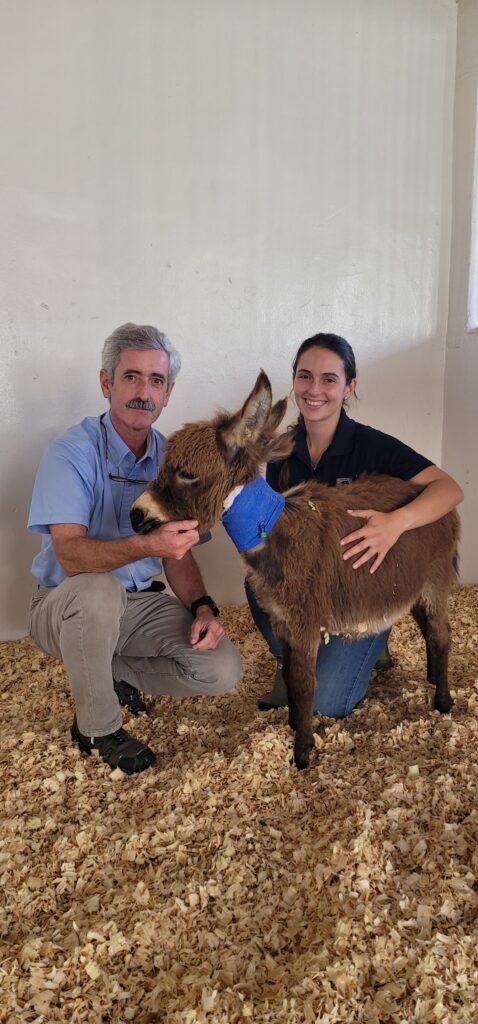
Photo courtesy of Dr. Fernando Marqués
Since coming home to the farm, Gypsy has returned to being energetic and running around with the other miniature donkeys and horses as she did when Masri first met her.
“As a new miniature donkey and horse owner, having a go-to for these animals at the beginning of their lives leaves me feeling so grateful and confident that I can handle anything with them,” said Masri. “Anytime I have an emergency, Palm Beach Equine Clinic will be the first place I call.”
“As a new miniature donkey and horse owner, having a go-to for these animals at the beginning of their lives leaves me feeling so grateful and confident that I can handle anything with them,” said Masri. “Anytime I have an emergency, Palm Beach Equine Clinic will be the first place I call.”
Since coming home to the farm, Gypsy has returned to being energetic and running around with the other miniature donkeys and horses as she did when Masri first met her. “As a new miniature donkey and horse owner, having a go-to for these animals at the beginning of their lives leaves me feeling so grateful and confident that I can handle anything with them,” said Masri. “Anytime I have an emergency, Palm Beach Equine Clinic will be the first place I call.”
Dr. Natalia Novoa has been part of the Palm Beach Equine Clinic team since 2011. Dr. Novoa focuses primarily on sport horse medicine, lameness, pre-purchase exams, chiropractic adjustments, acupuncture and preventative medicine.
When and why did you decide that you wanted to become a veterinarian?
I decided to become a veterinarian when I was in high school. I enjoyed working with animals at my family’s farm. I spent time with the farm’s vet, and I learned how to do artificial insemination before I even finished high school. I liked the problem-solving aspect of it. I found it fascinating to have the ability to identify and understand what the problem was and then help relieve the suffering of animals after injuries or illnesses. It was an indescribable sensation. Nothing beats helping an animal when they are sick or in pain. There is nothing more rewarding than knowing you are making a difference in a horse’s life. It is a very satisfying feeling.

Photo courtesy of Dr. Natalia Novoa
What aspects of equine medicine interest you most, and what types of cases do you find most rewarding?
I am most interested in sports medicine and lameness (conventional medicine) as well as alternative medicine (chiropractic adjustments and acupuncture). The most rewarding cases for me are the challenging ones where I have to “solve the puzzle.” I like when I have to rely on my detailed observation including a thorough exam and accurate history, then put together all the data and information I gathered from the diagnostic tools, choose the appropriate treatment, and then reach a successful outcome.
What do you enjoy most about working with performance horses?
I enjoy treating them as top athletes through the combined use of our practical skills, the new technology, and evolving therapies. At Palm Beach Equine Clinic, we are very fortunate to work on a variety of horses of all disciplines, including horses that are the best athletes in the world in dressage, show jumping, polo, etc. We use the most advanced equipment to provide the best service. Also, at Palm Beach Equine Clinic we have an amazing team of veterinarians with different specialties, knowledge, and skills to help these performance horses execute and perform at their best.

Photo courtesy of PBEC
What has been one of your favorite moments while working for Palm Beach Equine Clinic?
One of my favorite moments was when my daughter Lola told me she wanted to be a veterinarian after watching the process of resolving a challenging lameness case in a grand prix level show jumping mare. Lola was able to observe the positive outcome and cheered for the mare when she won a big jumper class.
What is something interesting that people may not know about you?
I am a fearless squash player, and I also enjoy playing tennis and ping pong. I love traveling with my family and showing my daughter Lola the world.
What is something interesting that people may not know about you?
I am a fearless squash player, and I also enjoy playing tennis and ping pong. I love traveling with my family and showing my daughter Lola the world.
The importance of good quality hoof care in competition horses cannot be denied. Farriery can be a major asset during the show season and beyond. The farrier can be proactive in keeping the horse’s feet healthy and thus preventing lameness. Learn more as Dr. Stephen O’Grady of Palm Beach Equine Clinic in Wellington, FL, explains the philosophy behind correct basic farriery in sport horses.
The Hoof
The equine hoof is unique as it is comprised of a group of biological structures (anatomy) that follow the laws of biomechanics. Therefore, if the veterinarian and farrier know the anatomy of the equine foot combined with an understanding of the biomechanics and good basic farriery principles, proper physiological farriery can be consistently applied (see Figure 1A and 1B). There are three important aspects of farriery used to keep the horse sound, beginning with the appropriate foot trim, along with the correct size and placement of the horseshoe.
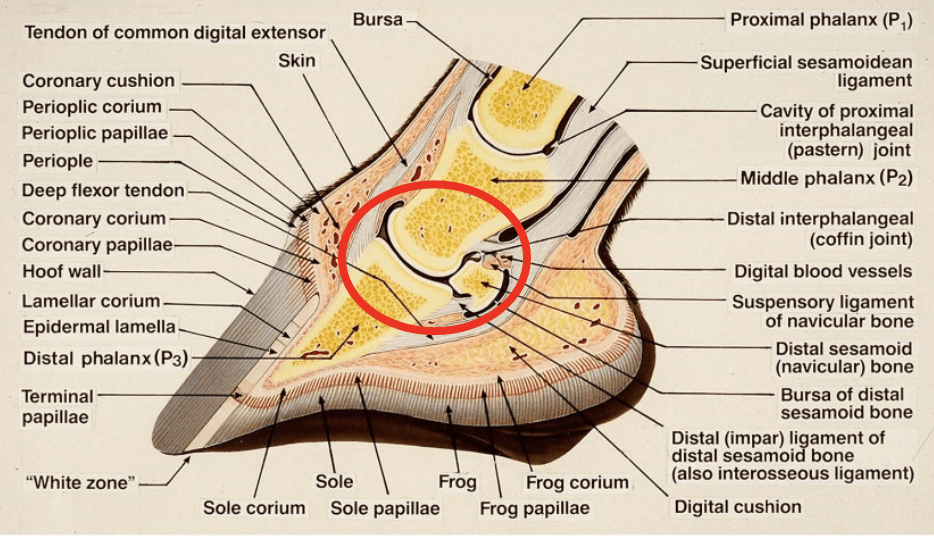
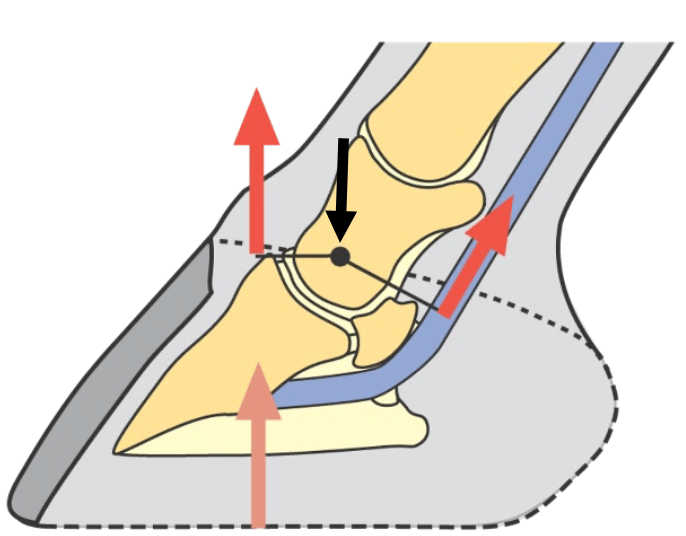
The farrier session begins with an evaluation of the conformation of each foot. This means viewing the foot from the front, the side, and behind to observe the height of the heel bulbs (see Figure 2). It is important for the clinician to observe the horse in motion to see whether the horse’s foot lands flat or slightly heel first, which is desired. If the horse lands markedly heel first with a toe flip, it is a sign the heels have migrated dorsally (toward the front), decreasing the ground surface in the palmar section of the foot, or the size of the shoes is too small. The foot that lands toe first is an indication that the musculotendinous unit of the deep digital flexor tendon is shortened or the horse is experiencing palmar foot pain. Lastly, the foot should be observed for an asymmetrical landing pattern that is dictated by limb conformation because, if severe, a heel bulb can be displaced proximally resulting in the foot conformation termed “sheared heels.”
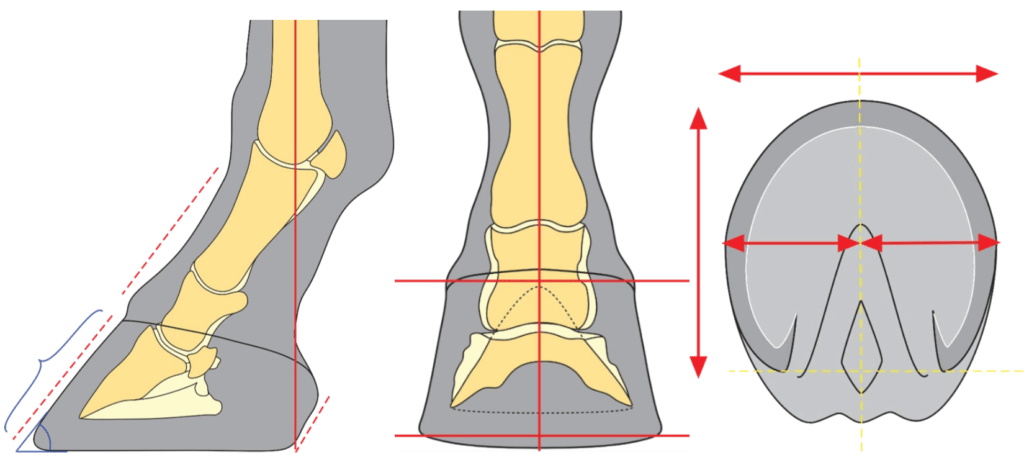
The Trim
The use of guidelines or landmarks when approaching the trim provides consistent, repeatable results that can be used on each foot regardless of the conformation. The three guidelines used are: 1. Trimming the foot to achieve a straight or parallel hoof-pastern axis, 2. using the widest part of the foot, which correlates closely with the center of rotation, and 3. trimming the palmar foot (heels) to the base of the frog or to where the heels of the hoof capsule and the frog are on the same plane (see Figure 3A and 3B). A closer look at these three guidelines, which are all interrelated, will help to show their importance.
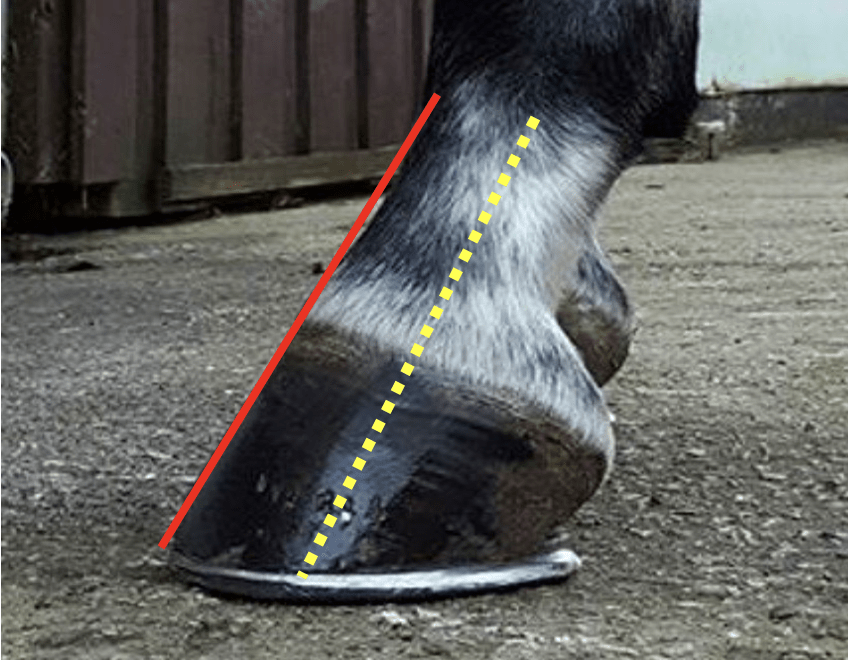
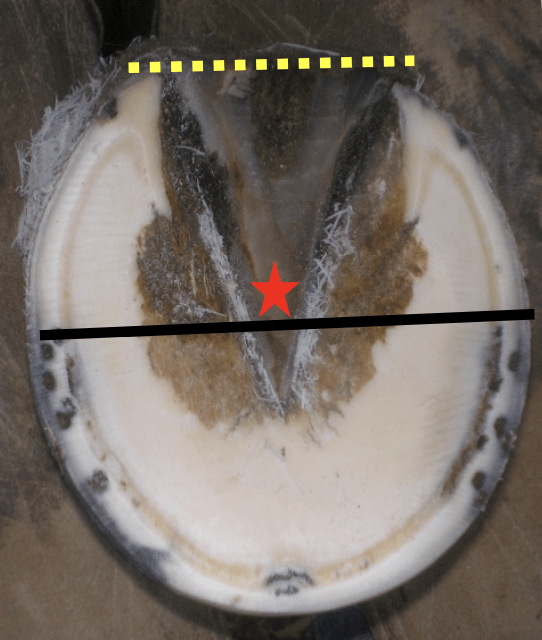
1. If the dorsal (front) surface of the pastern bone and the dorsal surface of the hoof are parallel or form a straight line, then the bones of the digit (in the hoof) are in a straight line, and the force from the weight of the horse will go through the center of the joint. Furthermore, and equally important, if the hoof-pastern axis is straight, the weight will be distributed evenly on the bottom or the solar surface of the foot.
2. The second guideline is the center of rotation (COR). The COR is located a few millimeters palmar (behind) the widest part of each foot. This guideline allows the farrier to apply the appropriate biomechanics to each foot. The foot is trimmed in approximate proportions on either side of the widest part of the foot, which addresses the moments on either side of the COR and provides biomechanical efficiency.
3. Lastly, the palmar section of the foot is trimmed to the base of the frog or trimmed such that the heels of the hoof capsule and the frog are on the same plane. Adherence to this guideline keeps the soft tissue structures (frog, digital cushion, ungula cartilages) within the hoof capsule, which is necessary to absorb concussion and dissipate the energy of impact (see Figure 4). It is important to remember that heels do not grow tall; they grow forward. If the heels migrate forward, the soft tissue structures will be forced in a palmar direction out of the hoof capsule. Furthermore, as the heels migrate forward, the weight is placed on the bone via the lamellae thus bypassing the soft tissue structures of the foot. Allowing the heels to migrate forward also decreases the ground surface of the foot. Two examples of this guideline are shown in Figures 5A, 5B and 6A, 6B where the palmar foot was managed appropriately, and a size larger shoe was applied.
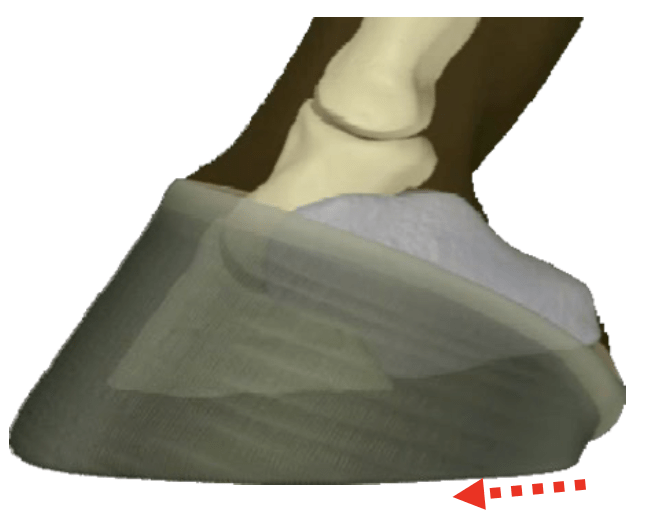
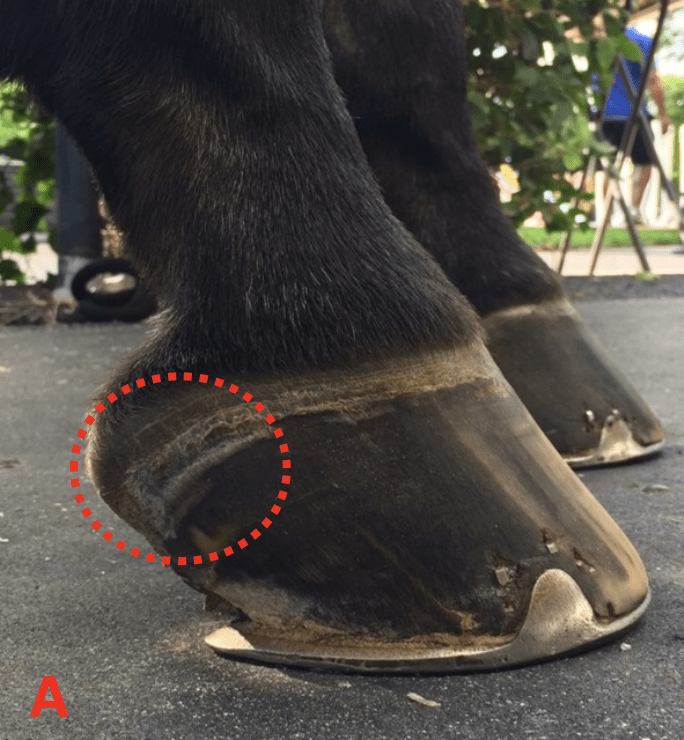


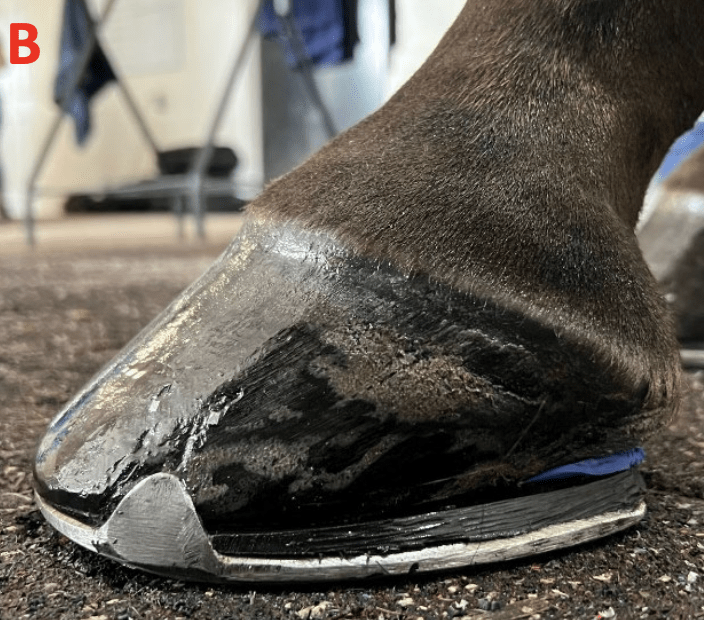
The three guidelines described here can be applied to any foot and can serve as a basis for maintaining a healthy foot and a basic starting point for applying farriery to a horse with poor foot conformation or one with a distorted hoof capsule. Figures 7A and 7B illustrate a hoof where all three of these guidelines have been applied.

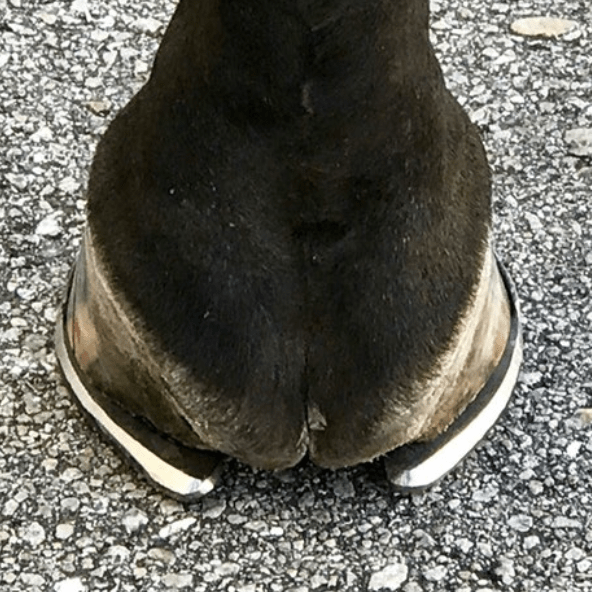
Thoughts From Dr. Stephen O’Grady
Most competition horses now show year-round instead of on a seasonal basis. My observation is based on years of experience regarding the farriery performed on these horses. Many of these horses are given a rest from competition prior to leaving for Wellington for the winter show season. Many horses arrive with very reasonable foot conformation. However, upon arrival, horses are often shod with various specialty shoes, wedges, pads, pour-ins, etc., as a means of protection and perhaps to enhance their performance.
As the season progresses and the workload becomes more intense, the sole thickness starts to decrease, and the feet become softer from multiple baths. Now the farriery that was applied for protection at the onset may be causing pressure on the thinner, softer structures of the foot, thus becoming somewhat detrimental. The horses continue to be trimmed and shod on a monthly basis, and the farrier may not be aware of the change in the integrity of the hoof structures, especially the sole, and perhaps some horses may be over-trimmed. As the season progresses into March, the structures of the foot deteriorate further as a result of the workload. Many horses begin to become foot sore. At this point, the farrier options become limited because all the protective methodology was already used at the beginning of the season.
One recommendation would be to refrain from trimming the sole (trade the hoof knife for a wire brush), create ground surface in the palmar foot with a rasp, and decrease toe length vertically from the dorsal section of the foot to preserve mass. Always remember that adequate breakover in the shoe is important, as it decreases the stress in the deep digital flexor tendon and decreases the moment about the distal interphalangeal joint, both of which preserve sole thickness.
I remember the words of Joe Pierce when I was an apprentice learning the farrier trade many years ago, “No one will know if you leave the last few rubs of the rasp on the foot, but everyone will know if you take a few too many rubs!”
Palm Beach Equine Clinic offers a farriery consultation service to both veterinarians and farriers. This unique service provides a second opinion or simply “another set of eyes” available to both professions when treating difficult farriery cases. Please call 561-793-1599 or visit equineclinic.com for more information.
Do you ever wonder what all those letters at the end of a veterinarian’s name actually mean? It is kind of like a secret language where they signify a variety of different veterinary qualifications. Palm Beach Equine Clinic explains how to crack the code of letters.
DVM
Doctorate of Veterinary Medicine: This qualification is given to graduates of veterinary colleges. Although this was once only for graduates of American veterinary colleges, the abbreviation is now given to graduates from several other universities around the world. The vast majority of the veterinarians at Palm Beach Equine Clinic are DVMs that earned their degrees at U.S. institutions.
DACVS
Diplomate of the American College of Veterinary Surgeons: Holders of this qualification are board-certified specialists in Surgery. Board-certified means that the veterinarian has a mastery of advanced knowledge and skills after completing required testing. At Palm Beach Equine Clinic, Dr. Robert Bruise, Dr. Jorge Gomez, Dr. Weston Davis, Dr. Liz Barrett, and Dr. Karen Beste are all specialist surgeons.
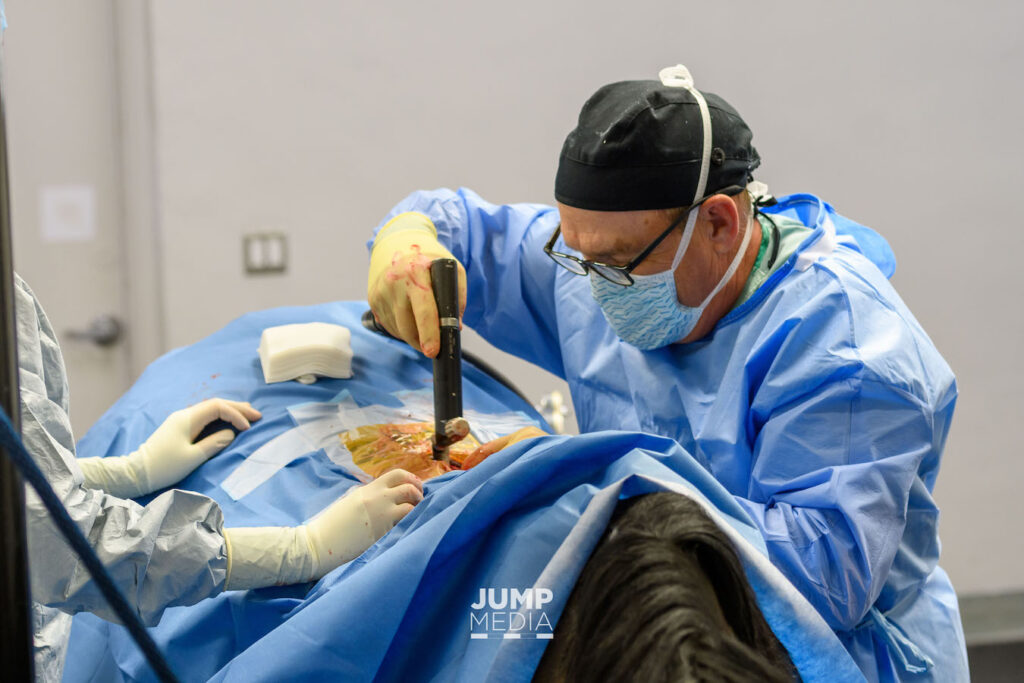
Photo by Jump Media
DACVIM
Diplomate of the American College of Veterinary Internal Medicine: This qualification means that the veterinarian is board-certified in Internal Medicine. Dr. Peter Heidmann and Dr. Fernando Marqués of Palm Beach Equine Clinic are both board-certified specialists in Internal Medicine.
DACVR
Diplomate of the American College of Veterinary Radiology: This qualification indicates the holder is a board-certified specialist in Radiology. Palm Beach Equine Clinic’s Dr. Sarah Puchalski is a DACVR.
DACVSMR
Diplomate of the American College of Veterinary Sports Medicine and Rehabilitation: A relatively new specialty, this qualification indicates the veterinarian is a board-certified specialist in Sports Medicine and Rehabilitation. Both Dr. Christopher Elliott and Dr. Fernando Marqués of Palm Beach Equine Clinic have this qualification.
BVETMED
Bachelor of Veterinary Medicine: This distinction is given to veterinary graduates of the Royal Veterinary College (RVC) in London, which is the first and oldest English-speaking veterinary college in the world. Dr. Richard Wheeler and Dr. Charlie McColough of Palm Beach Equine Clinic are both graduates of the famous RVC.
BVM&S
Bachelor of Veterinary Medicine & Surgery: These letters indicate a graduate of The Royal (Dick) School of Veterinary Studies in Edinburgh, Scotland, which is Scotland’s oldest veterinary school. Palm Beach Equine Clinic’s Dr. Sarah Allendorf is a Dick Veterinary graduate.
BVMS
Bachelor of Veterinary Medicine & Surgery: This particular abbreviation is given to graduates of several British veterinary schools. At Palm Beach Equine Clinic, Dr. Janet Greenfield Davis and Dr. Tyler Davis both have this qualification as graduates of the Glasgow University School of Veterinary Medicine.

Photo by Jump Media

Photo by Jump Media
BVSc
Bachelor of Veterinary Science: These letters were typically associated with veterinary graduates from Commonwealth countries such as Australia and New Zealand. The qualification is now granted by numerous vet schools around the world. Within Palm Beach Equine Clinic, Dr. Christopher Elliott has this qualification from the University of Queensland School of Veterinary Science in Australia.
MVB
Bachelor of Veterinary Medicine: This renowned abbreviation indicates graduates of the University College Dublin School of Veterinary Medicine, which is Ireland’s only veterinary school. Dr. Laura Hutton of Palm Beach Equine Clinic is a University College Dublin School graduate.
MVZ
Medico Veterinario Zootecnista: This qualification is given by several Spanish-speaking veterinary schools. Palm Beach Equine Clinic’s Dr. Jorge Gomez has this qualification as a graduate of the University of Caldas in Colombia.
MRCVS
Member of the Royal College of Veterinary Surgeons: These celebrated letters indicate the holder as satisfying the stringent regulatory requirements to practice as a Veterinary Surgeon in the United Kingdom. At Palm Beach Equine Clinic, Dr. Richard Wheeler, Dr. Scott Swerdlin, Dr. Stephen O’Grady, Dr. Janet Greenfield Davis, Dr. Tyler Davis, Dr. Charlie McColough, Dr. Sarah Allendorf, and Dr. Christopher Elliott are all MRCVS.
MANZCVS
Member of the Australian and New Zealand College of Veterinary Scientists: These letters indicate the veterinarian has studied at the Australian and New Zealand College of Veterinary Scientists and is an advanced practitioner in a particular area of veterinary science. Dr. Christopher Elliott of Palm Beach Equine Clinic is a MANZCVS in Equine Sports Medicine and Rehabilitation.

Photo courtesy of Dr. Christopher Elliott
CERPM
Certified in Equine Rehabilitation & Performance Medicine: This is a post-veterinary school qualification focusing on the early diagnosis of performance deficits, how to correct them, and rehabilitation after injury. Palm Beach Equine Clinic’s Dr. Janet Greenfield Davis holds this qualification.
CVA
Certified in Veterinary Acupuncture: Veterinarians with this post-veterinary school qualification have studied the fundamentals of equine acupuncture including points and techniques. This is a postgraduate qualification also held by Dr. Janet Greenfield Davis.
CVMMP
Certified Veterinary Medical Manipulation Practitioner: This is a post-veterinary school qualification where veterinarians are educated in how to perform medical manipulation to treat musculoskeletal problems. Dr. Ryan Lukens of Palm Beach Equine Clinic has this qualification.